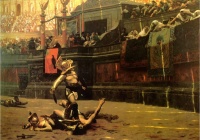Spectacle
From The Art and Popular Culture Encyclopedia
| "But certainly for the present age, which prefers the sign to the thing signified, the copy to the original, representation to reality, the appearance to the essence... illusion only is sacred, truth profane. Nay, sacredness is held to be enhanced in proportion as truth decreases and illusion increases, so that the highest degree of illusion comes to be the highest degree of sacredness. "Feuerbach, Preface to the second edition of The Essence of Christianity more... |


With the 16th century The Miseries and Disasters of War, French 17th artist Jacques Callot anticipated Goya's Disasters of War, both of them criticizing the horrors of war in their art

Illustration: screen shot from L'arrivée d'un train en gare de La Ciotat
|
Related e |
|
Featured: |
In general spectacle refers to an event that is memorable for the appearance it creates. While some literary critics and philosophers in the 20th century have offered a theory of "the spectacle" as a mode by which capitalism subordinates everyday experience (see Situationist spectacle), the term "spectacle" has also been a term of art in theater dating from the 17th century in English drama.
Contents |
Etymology
From Middle English, from Old French spectacle, from Latin spectaculum (“a show, spectacle”), from spectare (“to see, behold”), frequentative of specere (“to see”); see species.
Ancient origins
The term originated from the Roman practice of staging circuses, in the tradition of the Roman elite of providing "bread and circuses" to maintain civil order by distracting the populace from underlying social and economic problems.
Punishment as spectacle
The Restoration spectacle
The Hollywood spectacular
When the zoetrope and nickelodeon technology first appeared, the earliest films were spectacles. They caught the attention of common people. They showed things people would rarely see, and they showed it to the wide audience.
- Thomas Edison filmed Eiffel Tower, actual American Indians in a simulated attack, and even celebrated beauty queens.
- Louis Lumière filmed a train pulling into a station in 1895. The camera was in front of the train, and the train "came" directly at the viewer. It was a sensational because it gave an object of gaze.
Situationist notion of Spectacle and spectacular society.
Dicta
- “Television, the drug of a nation” --The Disposable Heroes of Hiphoprisy, 1992
- “The Revolution Will Not Be Televised” --Gil Scott-Heron, 1970
See also

